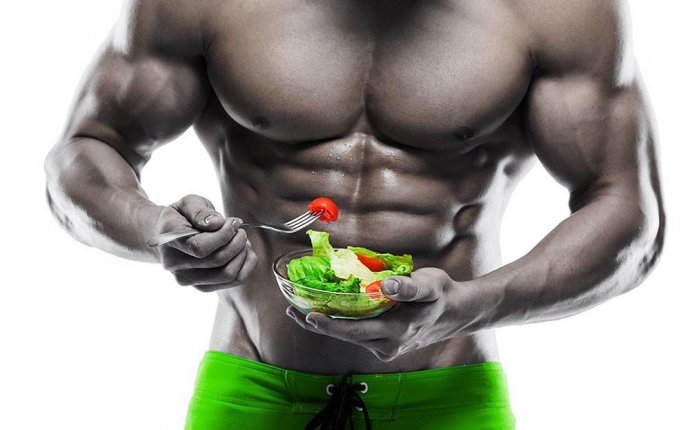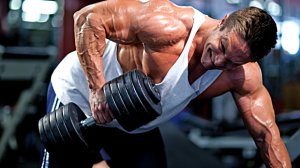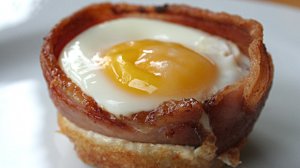
Build muscle while losing fat

- People who gain fat easily need better insulin sensitivity. Use metabolic techniques such as drop sets, supersets, complexes and intervals.
- Keep carbs low-ish much of the day, but use supplements containing carbs before and during workouts. Save the carby meals until after training.
- Heat therapy increases core temperature that turns on the "heat shock" response. This increases insulin sensitivity by suppressing inflammation and increasing blood flow.
- You can increase the amount of brown (good) fat you have by working your butt off. Similarly, you can activate brown fat by eating spicy foods and getting some sun.
- Glucose disposal agents increase insulin sensitivity and ensure that carbs are stored as glycogen in muscle instead of fat.
Gain Muscle Without Getting Fat
If you gain fat easily, following the diet and training advice meant to help skinny bastards gain muscle can backfire. Here are five ways that "easy fat gainers" can lose the chub and still build muscle.
1 – Lift with Frequency and Volume
Lifting heavy and lifting often is a given if muscle building is your goal, but if you're a fatty you need to take a slightly different approach than the 150-pound scrawny kid. High-volume training that keeps your heart rate elevated is perfect for guys (and girls) who lean more toward the endomorph somatotype.
Thankfully, heavy resistance training sensitizes muscle tissues to carbohydrates. After a heavy weight training session, your muscle cells are scrambling to soak up carbs to promote recovery. That means the higher your daily workout volume, the better you'll be sensitized to carbs.
In other words, you want to improve insulin sensitivity, which is pretty much a theme for endomorphs.
Take home message: Train with progressively higher volume as many times per week as your recovery allows, while incorporating metabolic techniques such as drop sets, supersets, complexes and interval cardio to maximize fat burning.
 2 – Carb Down When Inactive
2 – Carb Down When Inactive
Eliminating carbs entirely – otherwise known as a horrible diet – has negative connotations, and for good reason. The word "diet" alone suggests deprivation, bouts of starvation, and resisting temptation. Any diet that restricts things for too long is bound to fail.
But in general terms, those seeking fat loss need to keep insulin at bay during inactive times of the day. Sure, insulin is a potent inducer of amino acid uptake and protein synthesis, which makes it key to a muscular physique, but it's a double-edged sword.
Insulin is effective at driving carbs into muscle and liver tissue (good), but it's also equally good at directing carbs into fat tissue (bad).
To get the best of both worlds, skip the carbs at breakfast and during the early part of your workday. Instead, opt to replace carbs with healthy fats and keep your protein intake constant.
This means something like a three-egg omelet with spinach instead of a heavy carb-laden breakfast of pancakes and waffles (you can maybe eat those later in the day – see below).
That said, we don't want to catabolize muscle entirely and end up looking like a dude fresh off Weight Watchers. When your workout comes around, introduce carbs to maximize recovery.
This isn't particularly new info, but one study found that 50 grams of pure carbohydrates in a workout drink consumed during a resistance training session completely eliminated cortisol elevations compared to a control drink.
Subjects within this study with the lowest cortisol – and the greatest muscle gains – were entirely from the group who drank the carb drink, whereas subjects tested with the highest cortisol showed the least gains. One placebo participant on the control drink even lost muscle size during the study!
You want a workout nutrition drink containing cyclic dextrin (because of its low osmolality) and fast-acting di- and tripeptides that digest quickly and turn on protein synthesis.
Then you can follow up your workout with some complex carbohydrates – maybe even some fun ones in moderation – when your muscles are most sensitized to absorbing them.
 3 – Heat Things Up
3 – Heat Things Up
Heat therapy, the sauna being one example, improves insulin sensitivity by suppressing inflammation. You'll notice a theme here – insulin sensitivity is a common thread to fat loss and everything you can do to improve it should be a priority.
Soaking in a hot bath or sauna causes an increase in core body temperature that turns on the cellular "heat shock" response. This increases insulin sensitivity by suppressing inflammation and increasing blood flow to working muscles.
You can get similar effects from cold showers or cryotherapy on the opposite end of the spectrum, but I think most would make the choice to relax in a sauna over an ice bath.
Hitting the sauna a few times a week when you're off from the gym may be just what's needed to maintain heat-shock protein levels, which aren't activated during sedentary activities. Theoretically, this should help to maintain insulin sensitivity at or near training levels.
4 – Get Down With Brown
There are several types of fat cells, the most relevant being white and brown.
White fat cells actually constitute an endocrine organ and regulate a lot of bodily processes. The problem? If they get too big, so do you, through such mechanisms as insulin resistance, inflammation, and nasty cardiovascular events.
You're much better off keeping white fat cells at a minimum and focusing on creating an abundance of brown fat. If you're lean and less insulated with white fat, you'll already have a good amount of brown fat. If you aren't lean, you can do things to "enlist" brown fat:
Work your butt off.
A 2012 study found a protein produced in skeletal muscle during exercise that makes fat cells turn brown. So work, work, and work. You knew you had to do that anyway, but now you have another reason to push it hard.
Eat spicy foods and drink green tea.
Capsaicin in spicy peppers is thermogenic and appetite suppressive. Oddly, even though feeling cold seems to be the best way to turn on brown fat activity, the hot spice capsaicin mimics the effects of cold on brown fat, exciting it in much the same fashion. Green tea acts along a similar pathway.
Get a moderate amount of sun.
When the skin cells are browned, melanin is activated. This antioxidant, which has been shown to have anti-inflammatory properties, could be the body's natural defense against obesity-related conditions such as Type 2 diabetes because of those very same anti-inflammatory effects on fat cells.
You may have also heard of a compound called Melanotan II, which activates melanin, thereby increasing brown fat activity. It's been used experimental as a tanning and weight loss agent.
Eat the right foods.
Conjugated Linoleic Acid (CLA) and Essential Fatty Acids are found in abundance in wild fish and grass-fed meats, as well as supplements. These mimic the activity of brown fat cell activity by stimulating fatty acid oxidation.








